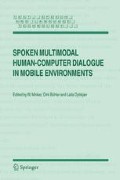Abstract
We propose a set of feature functions for dialogue course management and investigate their effect on the system's behaviour for choosing the subsequent dialogue action during a dialogue session. Especially, we investigate whether the system is able to detect and resolve ambiguities, and if it always chooses that state which leads as quickly as possible to a final state that is likely to meet the user's request. The criteria and data structures used are independent of the underlying domain and can therefore be employed for different applications of spoken dialogue systems. Experiments were performed on a German in-house corpus that covers the domain of a German telephone directory assistance.
Access this chapter
Tax calculation will be finalised at checkout
Purchases are for personal use only
Preview
Unable to display preview. Download preview PDF.
References
Abella, A. and Gorin, A. L. (1999). Construct Algebra: Analytical dialog management. In Proceedings of Annual Meeting of the Association for Computational Linguistics (ACL), pages 191–199, University of Maryland, USA.
Ammicht, E., Potamianos, A., and Fosler-Lussier, E. (2001). Ambiguity representation and resolution in spoken dialogue systems. In Proceedings of European Conference on Speech Communication and Technology (EURO-SPEECH), pages 2217–2220, Aalborg, Denmark.
Aust, H., Oerder, M., Seide, F., and Steinbiss, V. (1995). The Philips automatic train timetable information system. Speech Communication, 17:249–262.
Constantinides, P., Hansma, S., Tchou, C., and Rudnicky, A. (1998). A schema based approach to dialog control. In Proceedings of International Conference on Spoken Language Processing (ICSLP), pages 409–412, Sidney, Australia.
Hirsch, H.-G. and Pearce, D. (2000). The aurora experimental framework for the performance evaluation of speech recognition systems under noisy conditions. In Proceedings of International Workshop on Automatic Speech Recognition: Challenges for the new Millenium, pages 181–188, Paris, France.
Kanthak, S., Sixtus, A., Molau, S., Schlüter, R., and Ney, H. (2000). Fast search for large vocabulary speech recognition. Verbmobil: Foundations of Speechto-Speech Translation, pages 63–78.
Levin, E. and Pieraccini, R. (1995). Concept-based spontaneous speech understanding system. In Proceedings of European Conference on Speech Communication and Technology (EUROSPEECH), pages 555–558, Madrid, Spain.
Lleida, E. and Rose, R. C. (1996). Efficient decoding and training procedures for utterance verification in continuous speech recognition. In Proceedings of International Conference on Acoustics, Speech and Signal Processing (ICASSP), pages 507–510, Atlanta, Georgia, USA.
Macherey, K., Och, F. J., and Ney, H. (2001). Natural language understanding using statistical machine translation. In Proceedings of European Conference on Speech Communication and Technology (EUROSPEECH), pages 2205–2208, Aalborg, Denmark.
Pearce, D. (2000). Enabling new speech driven services for mobile devices: An overview of the ETSI standards activities for distributed speech recognition front-ends. In Proceedings of Applied Voice Input/Output Society Conference, San Jose, California, USA.
Potamianos, A., Ammicht, E., and Kuo, H.-K. J. (2000). Dialogue management in the Bell Labs Communicator system. In Proceedings of International Conference on Spoken Language Processing (ICSLP), pages 603–606, Beijing, China.
Seneff, S. and Polifroni, J. (1996). A new restaurant guide conversational system: Issues in rapid prototyping for specialized domains. In Proceedings of International Conference on Spoken Language Processing (ICSLP), pages 665–668, Philadelphia, Pennsylvania, USA.
Weintraub, M., Beaufays, F., Rivlin, Z., Konig, Y., and Stolcke, A. (1997). Neural-network based measures of confidence for word recognition. In Proceedings of International Conference on Acoustics, Speech and Signal Processing (ICASSP), pages 887–890, Munich, Germany.
Wessel, F., Macherey, K., and Schlüter, R. (1998). Using word probabilities as confidence measures. In Proceedings of International Conference on Acoustics, Speech and Signal Processing (ICASSP), pages 225–228, Seattle, Washington, USA.
Wessel, F., Schlüter, R., Macherey, K., and Ney, H. (2001). Confidence measures for large vocabulary continuous speech recognition. IEEE Transactions on Speech and Audio Processing, 9(3):288–298.
Author information
Authors and Affiliations
Editor information
Editors and Affiliations
Rights and permissions
Copyright information
© 2005 Springer
About this chapter
Cite this chapter
Macherey, K., Ney, H. (2005). Feature Functions for Tree-Based Dialogue Course Management. In: Minker, W., Bühler, D., Dybkjær, L. (eds) Spoken Multimodal Human-Computer Dialogue in Mobile Environments. Text, Speech and Language Technology, vol 28. Springer, Dordrecht. https://doi.org/10.1007/1-4020-3075-4_4
Download citation
DOI: https://doi.org/10.1007/1-4020-3075-4_4
Published:
Publisher Name: Springer, Dordrecht
Print ISBN: 978-1-4020-3073-4
Online ISBN: 978-1-4020-3075-8
eBook Packages: Computer ScienceComputer Science (R0)

